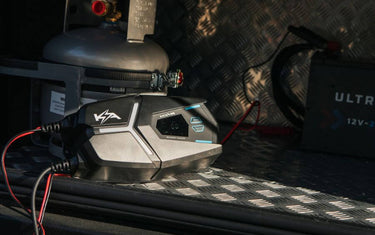If you spend time camping, travelling, or running an off-grid setup, you’ve probably heard about ACDC chargers. These handy devices let you take power from a standard wall outlet or generator (AC power) and convert it into the type of energy your batteries and 12V gear need (DC power).
An ACDC charger is one of the easiest ways to keep your batteries topped up whenever you have access to mains or generator power. In this guide, we’ll cover what they do, why they’re useful, and how to choose the right one for your setup.
What Is an ACDC Charger?
An ACDC charger takes the alternating current (AC) that comes from a household socket or generator and turns it into direct current (DC) to charge your batteries. Without it, you wouldn’t be able to safely connect your 12V system to mains power.
They’re sometimes called mains chargers or AC battery chargers, and they’re especially handy for people who move between powered campsites, home storage, and off-grid travel.

How Do ACDC Chargers Work?
Think of an ACDC charger as a middleman.
- Step 1 – Plug In: You connect the charger to a wall outlet or generator.
- Step 2 – Conversion: The charger converts that incoming AC power into DC power at the correct voltage for your battery.
- Step 3 – Smart Charging: Many modern chargers use multi-stage charging to safely fill your battery to 100 percent, then switch to a maintenance mode so it stays healthy.
The important thing to know is this – ACDC chargers make it safe and easy to plug into the grid without worrying about overcharging or damaging your battery.
Key Features to Look For
When choosing an ACDC charger, here are the most important things to keep in mind:
- Battery Compatibility: Make sure the charger supports your battery type (AGM, Gel, or Lithium).
- Amperage (Output Power): A higher amp charger will recharge your battery faster. For example, a 40A charger will top up a flat battery quicker than a 20A model.
- Multi-Stage Charging: Protects your battery by adjusting how much power goes in at each stage.
- Portability and Build Quality: Look for compact designs, sturdy casings, and cooling fans if you’ll be using it in hot or enclosed areas.
- Safety Protections: Overload, short circuit, and thermal protection keep both you and your gear safe.
Benefits of Using an ACDC Charger
- Fast, reliable charging whenever mains power is available.
- Better battery health thanks to smart multi-stage charging.
- Easy to use – just plug in and let the charger do the rest.
- Versatile – works at home, at a powered campsite, or with a generator.

Common Applications
You’ll usually find ACDC chargers being used for:
- Charging 12V batteries at home between trips.
- Powering up at caravan parks and powered campsites.
- Topping up batteries with a generator during extended stays off-grid.
- Back-up charging if your DCDC or solar system isn’t getting enough sun or alternator time.
ACDC vs DCDC Chargers – What’s the Difference?
It’s easy to confuse the two, but here’s the simple breakdown:

Keep in mind that most off-grid setups benefit from having both – an ACDC charger for when power points are handy, and a DCDC charger for everywhere else.
When Should You Choose an ACDC Charger?
An ACDC charger is the right choice if:
- You often stay at powered campsites.
- You want to charge your battery at home between trips.
- You use a generator as part of your off-grid setup.
- You want a backup option alongside DCDC or solar charging.
Conclusion
An ACDC charger is a must-have if you ever connect to mains or generator power. It’s simple to use, safe for your batteries, and ensures you’re always ready for your next trip. Paired with a DCDC or solar setup, it gives you a complete charging solution for every adventure.
Browse our range of KickAss ACDC chargers, and if you’re not sure what’s right for you, drop into one of our retail stores or give us a call on (07) 3123 4715. Our team of 12V experts will be happy to chat.

































































































